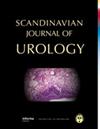Transurethral versus open enucleation of the prostate in Sweden – a retrospective comparative cohort study
IF 1.4
4区 医学
Q3 UROLOGY & NEPHROLOGY
引用次数: 0
Abstract
Objective: To investigate if treatment with transurethral enucleation of the prostate (TUEP) during the learning curve is as efficient and safe in the short term as transvesical open prostate enucleation (OPE), in patients with benign prostatic obstruction (BPO) > 80 ml in a population in Sweden. Methods: 54 patients with ultrasound verified BPO > 80 ml and indication for surgery underwent TUEP or OPE between 2013 and 2019. Peri- and postoperative outcome variables regarding voiding efficiency and morbidity from 20 OPE at Skåne University Hospital (SUS) and from the first 34 TUEP performed at SUS and Ystad Hospital were retrospectively assembled. Follow-up data from the first 6 postoperative months were collected by chart review. Results: Intraoperative bleeding during TUEP was less than in OPE (225 ml vs. 1,000 ml). TUEP took longer surgery time than OPE (210 vs. 150 min.). Within 30 days postoperatively, bleeding occurred less often after TUEP (23% vs. 40%), requiring one fourth of the blood transfusions given after OPE. After TUEP, patients had shorter hospitalisation (3 days vs. 7 days) and catheterisation time (3 days vs. 12 days). During the 6-month follow-up period, incontinence and UTI defined as symtomatic significant bacteriuria (urinary culture) were observed as main complications after TUEP and OPE. Functional outcome data availability (International Prostate Symptom Score [IPSS] questionnaire, uroflowmetry, residual urine) were limited. Conclusions: Treatment with TUEP during the learning curve led to less bleeding, shorter hospitalisation- and catheterisation time than treatment with OPE. However, surgery time was shorter with OPE. There were no major differences between the groups concerning mid-term functional outcomes, with the reservation of an inconsistent follow-up.瑞典经尿道前列腺切除术与开放式前列腺切除术的回顾性队列比较研究
目的:研究瑞典人群中良性前列腺梗阻(BPO) > 80 ml的患者,在学习曲线期间经尿道前列腺摘除(TUEP)的短期治疗是否与经膀胱开放性前列腺摘除(OPE)一样有效和安全。方法:2013 - 2019年,54例超声证实BPO > 80ml且有手术指征的患者行TUEP或OPE手术。回顾性收集了来自sk大学医院(SUS)的20例开腹手术和来自SUS和Ystad医院的前34例开腹手术的围期和术后结果变量,包括排尿效率和发病率。术后前6个月的随访资料通过图表复习收集。结果:TUEP术中出血少于OPE术中出血(225 ml vs 1,000 ml)。TUEP比OPE的手术时间更长(210分钟vs 150分钟)。在术后30天内,TUEP术后出血发生率较低(23%对40%),需要的输血量为OPE术后输血量的四分之一。TUEP后,患者住院时间缩短(3天对7天),置管时间缩短(3天对12天)。在6个月的随访期间,尿失禁和尿路感染(UTI)被定义为有症状的显著细菌尿(尿培养)是TUEP和OPE术后的主要并发症。功能结局数据(国际前列腺症状评分[IPSS]问卷、尿流测定、残余尿)的可用性有限。结论:与OPE治疗相比,在学习曲线期间使用TUEP治疗可减少出血,缩短住院和置管时间。然而,开窗手术时间较短。在中期功能结局方面,两组之间没有重大差异,保留了不一致的随访。
本文章由计算机程序翻译,如有差异,请以英文原文为准。
求助全文
约1分钟内获得全文
求助全文
来源期刊

Scandinavian Journal of Urology
UROLOGY & NEPHROLOGY-
CiteScore
2.90
自引率
6.70%
发文量
70
期刊介绍:
Scandinavian Journal of Urology is a journal for the clinical urologist and publishes papers within all fields in clinical urology. Experimental papers related to clinical questions are also invited.Important reports with great news value are published promptly.
 求助内容:
求助内容: 应助结果提醒方式:
应助结果提醒方式:


